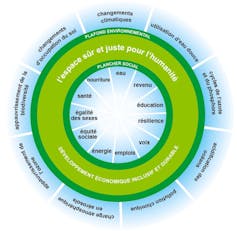How to leverage accounting to meet environmental challenges
What is accounting? It is primarily an information system designed to aid decision-making and accountability. It is not just a matter of seeing, but of seeing in order to act in an era that is increasingly referred to as the Anthropocene. This term refers to the period in history since which human actions have had as much impact on ecosystems as natural forces.
Christelle Chaplais, Clermont Auvergne University (UCA); Bastien David, University of Montpellier; Eugénie Faure, Audencia and Nicolas Antheaume, University of Nantes

The word connotes concerns about the long-term viability of human societies. Our work explores three dimensions through which accounting can report on the impact of human activities on the environment, report in order to take action.
The donut as a reference
The hypothesis of unprecedented climatic and even geological upheaval, which scientists refer to as the Anthropocene, should lead everyone, individually and collectively, to rethink the way they act, consume, and travel. The scientific diagnosis seems radical and shows the extent to which human activities have an impact on the environment.
However, it must be acknowledged that it is currently extremely difficult to determine the extent to which each action and behavior contributes to slowing down or accelerating the consequences of the Anthropocene. Without a common frame of reference, how can individuals set goals and determine where they stand?
There are numerous standards designed for companies. They are mainly used by large corporations that are required to publish non-financial information in their reporting documents.
Some private international bodies are more inclined to cover only the ESG impacts of companies (environmental, social, and governance impacts), using a simple materiality approach: in other words, their objective is simply to inform investors about their risks as measured by ESG criteria.
On the other hand, the European Union is seeking to establish a framework for non-financial reporting that takes into account dual materiality, i.e., an analysis that incorporates both the impact of a company's ESG risks and the company's impact on society. However, the connection between financial and non-financial reporting remains fragile.

Oxfam France
The information provided allows us to at least understand the company's carbon footprint or its contribution to the UN's Sustainable Development Goals. However, very few benchmarks allow us to understand how the company measures up against the goals set by scientists, goals that determine, quite simply, life on earth!
Many people today are calling on organizations to change their compass and share a common frame of reference, for example by considering the doughnut theory when organizing their balance sheets.
This approach, developed by British economist Kate Raworth, embeds business activity between a social and societal floor, which recognizes that we cannot give up everything in the name of the environment, and a ceiling corresponding to the planetary environmental limits popularized by Swedish researcher Johann Rockström and his co-authors.
To provide a common methodology
This common methodology can only be effective if it is supported and promoted by an organization withlegitimate authority. One example is the Accounting Standards Authority in France (ANC).
To be legitimate, an authority for Anthropocene accounting should involve both producers and users of accounting information, drawing on recognized scientific knowledge.
No authority based on this model exists today. In reality, there are a multitude of normative proposals, most of which are non-binding. A legitimate authority could take on the following responsibilities:
- produce standards relating to the publication of environmental information;
- provide a methodology, accounting system, and units of measurement (physical, monetary, or other) necessary to collect, calculate, or estimate the information. This could be an opportunity to propose units that are not monetary but are consistent across all impacts. One could, for example, consider measuring the number of years a company has left before its impacts prevent it from continuing to operate normally, once it has already consumed its share of viable economic space.
- provide a framework for presenting this information and give users access to assumptions and calculation methods;
- ensure the traceability of the information produced and its verifiability in the context of an audit;
- define the penalties that may be imposed in the event of non-compliance with these obligations.
American reporting expert Bill Baue even calls for the creation of an authority that would go further and be responsible for allocating planetary boundary quotas at the level of each entity. He proposes calling it the GTAC, for "Global Thresholds for Allocation Council."
Everyone concerned
Accountability and decision-making support: through its various functions, accounting makes the responsibilities of different stakeholders visible. Organizations and consumers must therefore be able to understand the limitations imposed on them.
In order for the Anthropocene to be visible to decision-makers within an organization, they must have access to information that helps them understand the consequences of their decisions on the state of the natural environment and society.
Decision-makers must therefore have tools that enable them to simulate the consequences of their choices: what will be the impact of packaging (cardboard, glass, etc., reusable or not), formulation (liquid or solid product), or supplier (location, country of origin, supplier's wage policy)?

Alexas_fotos/Pixabay, CC BY-SA
The same applies to consumers. Accounting will make the Anthropocene visible if it can translate the act of purchasing into a contribution to environmental protection or the achievement of a social objective. In this regard, there is still significant work to be done on the means to be deployed to assist consumers, particularly through product labeling.
The ultimate stage of success will be when our behaviors have internalized the Anthropocene to such an extent that it becomes both present and invisible once again.
This article was written by a group of researchers as part of a collaborative "speed blogging" event organized alongside the CSEAR France/EMAN Europe 2021 online academic conference. The speed blogging event involved writing an article on the conference theme of "sustainable development accounting in the Anthropocene" in a limited amount of time, working collaboratively. At the end of the event, three articles were co-written by senior researchers, junior researchers, and doctoral students..![]()
Christelle Chaplais, Professor Audit and Accounting Ethics, Clermont Auvergne University (UCA); Bastien David, PhD student and Associate Professor of Economics and Management, University of Montpellier; Eugénie Faure, PhD student in multi-capital accounting for SMEs, Audencia and Nicolas Antheaume, Professor of Accounting for Sustainable Development, University of Nantes
This article is republished from The Conversation under a Creative Commons license. Readthe original article.